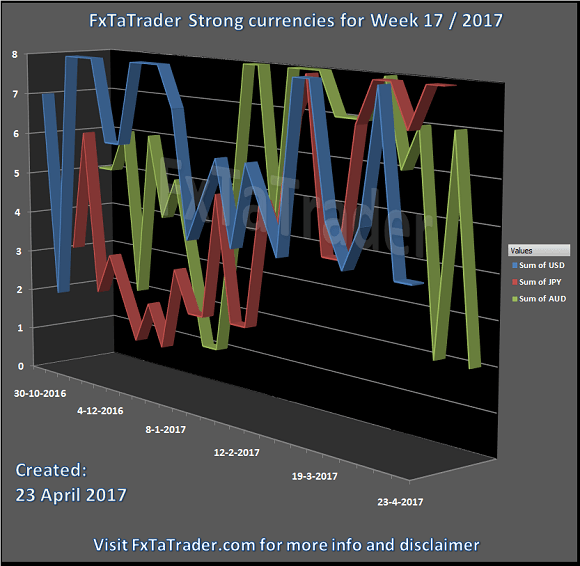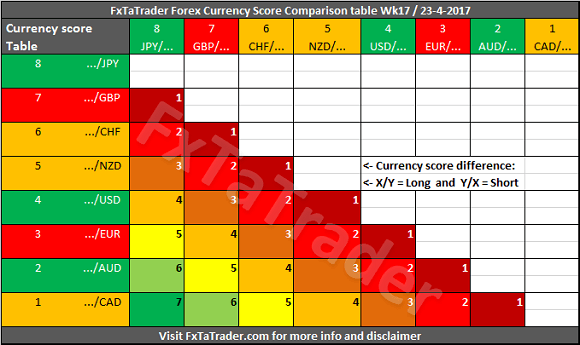In the Currency Strength table, the JPY was again the strongest currency while the CAD was the weakest. There were some significant changes last week with the CHF gaining 4 points and the EUR 2 points. The AUD lost 5 points and the CAD 2 points. The other currencies remained around the same level of last week with a maximum difference of just 1 point.
______________________________________
13 Weeks Currency Score Strength
The 13 Weeks Currency Strength and the 13 Weeks Average are provided here below. This data and the "13 weeks Currency Classification" are considered for deciding on the preferred range. Because it is not ideal nor desired to change the range for a currency every single week, we perform several checks to avoid this.
1. First of all the strength over a period of the last 13 weeks is considered. See each row for more information.
2. Next, the 13 weeks average is considered, see the last row called "Avg. 13 wks."
3. The number of weeks that a currency was stronger than another currency can also be considered.
4. The Technical Analysis (TA) Charts for each Time Frame could also be consulted.
For analyzing the best pairs to trade looking from a longer-term perspective the last 13 weeks Currency Classification can be used in support.
This was updated on 9 April 2017 and is provided here for reference purposes:
Strong: USD, JPY, AUD. The preferred range is from 6 to 8.
Neutral: CHF, NZD, CAD. The preferred range is from 3 to 5.
Weak: EUR, GBP. The preferred range is from 1 to 2.
When looking at the Average 13 wks. Score the AUD remains the strongest of all even after having to weeks of a low score during the last 3 weeks. The EUR remains the weakest and after that the GBP which had 4 strong weeks in a row lately. The currencies are grouped together around a level which makes clear to what classification they fit best. It is clear to see in the Avg. 13 wks. values to what groups the currencies belong.
_____________________________________
Classification review
This week we take a look at the strong currencies. The AUD is very volatile lately by going in the last 4 weeks to scores of 7 and 2. These are scores resp. in the Strong and Weak range.
The USD is less volatile but is lately having more scores in the range of Neutral currencies with sometimes making a top in the range of the Strong currencies. Actually, this is the case in the last 13 weeks. In the 13 weeks before that, it was clearly almost all the time in the range of the Strong currencies.
The JPY is clearly back on track after the strong dip it had in December last year. It is the strongest currency of last week and the second strongest when looking at the Average 13 wks. score being close behind the AUD. The JPY had in the last 6 weeks 4 scores of 8 and 2 scores of 7 and in the 6 weeks before that scores within the Neutral and Strong range.
For the moment these currencies will remain strong and it seems that the JPY may become the one with the highest Average 13 wks. score in the near future. The USD is the weakest of the Strong currencies by having a score of around 0,5 point lower to the other strong currencies. However, it is still too far from the neutral currencies to become one in the near future.
Below you can see the Weekly Currency Score Chart with the 6 months' data as a reference.

_____________________________________
Currency Score Comparison
"Comparison table" and the "Ranking and Rating list"
The Forex Currency Comparison Table compares each currency with its counterpart based on the Currency Score. For more information about the currency Score of this week, you can read the article "Forex Ranking, Rating and Score" which is published every week together with this article.
By using the comparison table directly below you can get a view without the volatility and statistics as opposed to the "Ranking and Rating list". Only the strength of each currency against the counterparts is analyzed by using the Technical analysis charts of the 4 Time Frames that are also used for the "Ranking and Rating List".
The information from the Comparison Table is the source for calculating the "Ranking and Rating List" where this list additionally uses the volatility and statistics for creating the best and worst performer in the list from number 1 to 28.
The information is published once a week and the rates change during the week. The mentioned scores also change and different opportunities may show up during the week. There are many ways to follow the rate changes during the week. This can be done e.g. by looking at the charts of course and checking e.g. the Ichimoku and/or MACD in the Daily and 4 Hours chart. There are also many tools, apps and websites where the development of rates of currencies is shown in different automated ways. This may be by pips or percentage difference or by comparing the values of indicators like the RSI, Moving Averages, MACD, Ichimoku etc. On my blog is a Heatmap available that can be of use also.
"Comparison table" and the "Currency Score Chart"
The additional value of this table compared to the Currency Score table is that the Comparison Table compares the strength between the currencies of each pair. By subtracting the strength of the weaker currency from the stronger currency we have a way to compare each pair combination.
The comparison table provides a way to compare currencies from a longer-term perspective of 13 weeks and also simultaneously taking the current trend into account. By coloring the currencies in the X and Y axis according to their Classification we can show what the best combinations are. In doing this we apply 2 rules to make it clearer.
1. First of all, only better-classified currencies in combination with weaker classified currencies are Approved when there is a Currency Score difference of at least 1 in the current week.
2. The only exception is when 2 currencies are similarly classified but the Currency Score difference is equal to or more than 4.
3. It means that each currency should be as far apart from each other as possible in the range from 1 to 8. The classification of the currencies in question may change in the longer term. By using the difference of 4 which is exact at the half of the range it seems a safe approach for trading 2 currencies which are similarly classified.
4. Even though currencies may be in the same classification a currency may be in a weaker/stronger period and may even change its classification in the future. See the current classification for the coming period at the beginning of this article.
______________________________________
Putting the pieces together
Based on the last "13 Weeks currency classification" and the "Currency Comparison Table" the most interesting currencies for going long seem to be the:
JPY and CHF.
These are Strong or Neutral currencies from a longer term perspective when looking at the last "13 Weeks currency classification".
For going short the same analysis can be done and the following currencies seem to fit best:
EUR and CAD.
These are Weak or Neutral currencies from a longer term perspective.
Currencies with a high deviation seem less interesting to trade because they are less predictable. A good example now is/are e.g. the:
GBP and AUD.
______________________________________
Besides this article, I also use the Forex "Ranking, Rating and Score" which is also available once a week on my blog. In the article "Ranking, Rating and Score" we look in more detail at the absolute position of the currencies and pairs.
It is recommended to read the page "Currency score explained", "Introduction to the FxTaTrader Forex Models" and "Statistics and Probabilities" for a better understanding of the article. If you would like to use this article then mention the source by providing the URL FxTaTrader.com or the direct link to this article. Good luck in the coming week.
The articles are my personal opinion, not recommendations, FX trading is risky and not suitable for everyone.The content is for educational purposes only and is aimed solely for the use by ‘experienced’ traders in the FOREX market as the contents are intended to be understood by professional users who are fully aware of the inherent risks in forex trading. The content is for 'Forex Trading Journal' purpose only. Nothing should be construed as recommendation to purchase any financial instruments. The choice and risk is always yours. Thank you.
Recommended Content
Editors’ Picks

USD/JPY pops and drops on BoJ's expected hold
USD/JPY reverses a knee-jerk spike to 142.80 and returns to the red below 142.50 after the Bank of Japan announced on Friday that it maintained the short-term rate target in the range of 0.15%-0.25%, as widely expected. Governor Ueda's press conference is next in focus.

AUD/USD bears attack 0.6800 amid PBOC's status-quo, cautious mood
AUD/USD attacks 0.6800 in Friday's Asian trading, extending its gradual retreat after the PBOC unexpectedly left mortgage lending rates unchanged in September. A cautious market mood also adds to the weight on the Aussie. Fedspeak eyed.

Gold consolidates near record high, bullish potential seems intact
Gold price regained positive traction on Thursday and rallied back closer to the all-time peak touched the previous day in reaction to the Federal Reserve's decision to start the policy easing cycle with an oversized rate cut.

Ethereum rallies over 6% following decision to split Pectra upgrade into two phases
In its Consensus Layer Call on Thursday, Ethereum developers decided to split the upcoming Pectra upgrade into two batches. The decision follows concerns about potential risks in shipping the previously approved series of Ethereum improvement proposals.

Bank of Japan set to keep rates on hold after July’s hike shocked markets
The Bank of Japan is expected to keep its short-term interest rate target between 0.15% and 0.25% on Friday, following the conclusion of its two-day monetary policy review. The decision is set to be announced during the early Asian session.

Moneta Markets review 2024: All you need to know
VERIFIED In this review, the FXStreet team provides an independent and thorough analysis based on direct testing and real experiences with Moneta Markets – an excellent broker for novice to intermediate forex traders who want to broaden their knowledge base.

